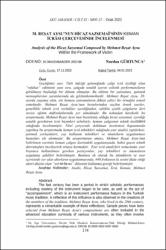M. Reşat Aysu’nun Hicaz Sazsemaî’sinin keman icrâsı çerçevesinde incelenmesi
Künye
Gürtunca, N. (2023). M. REŞAT AYSU’NUN HİCAZ SAZSEMAÎ''SİNİN KEMAN İCRÂSI ÇERÇEVESİNDE İNCELENMESİ . Afyon Kocatepe Üniversitesi Akademik Müzik Araştırmaları Dergisi , IX (17) , 174-193 .Özet
Geçtiğimiz asır, Türk müziği geleneğinde çalgı icrâ özelliği olan “refakat” ediminin yanı sıra, çalgıda ustalık içeren solistik performansların görülmeye başladığı bir dönem olmuştur. Bu etkinin bir yansıması, gelenek mensuplarının yaratılarında da gözlemlenmektedir. Mehmet Reşat Aysu, 20. asırda yaşamış olan, söz konusu yansımaların dikkat çekici bir örneğini temsil etmektedir. Mehmet Reşat Aysu’nun bestelerinden seçilen örnek eserler, genellikle teknik icrâ zorlukları içerdiğinden, sıklıkla çeşitli çalgıların ileri seviye eğitim müfredatlarında yer almaktadır. Bu noktadan hareketle bu araştırmada, Mehmet Reşat Aysu’nun bestelemiş olduğu hicaz sazsemaî, içerdiği ustalık gerektiren icrâ biçimleri sebebiyle, keman çalgısının teknik özellikleri odağında incelenmiştir. Nitel çerçevede doküman incelemesi kapsamında yapılmış bu araştırmada keman icrâ teknikleri odağında eser analizi yapılırken; parmak yerleşimleri, yay kullanım teknikleri ve nüansların uygulanması hususları ele alınmıştır. Bu araştırmanın amacı, Mehmet Reşat Aysu’nun belirlenen eserinin keman çalgısı üzerindeki uygulanışında, bahsi geçen teknik davranışları inceleyerek ortaya koymaktır. Eser icrâ analizleri sonucunda, eser boyunca kullanılması gereken pozisyonlar, yay teknikleri ve nüansların uygulanış şekilleri belirtilmiştir. Bunlara ek olarak bu tekniklerin ve eser içerisinde yer alan akorların uygulanmasında, 440 frekansın la sesini ifade ettiği akort düzeni olan “sol-re-la-mi” düzenini kullanma gereği belirlenmiştir. The last century has been a period in which soloistic performances including mastery of the instrument began to be seen, as well as the act of "accompaniment", which is an instrument performance feature in the Turkish music tradition. A reflection of this influence is also observed in the creations of the members of the tradition. Mehmet Reşat Aysu, who lived in the 20th century, represents a remarkable example of these reflections. Sample pieces have been selected from Mehmet Reşat Aysu's compositions are often included in the advanced education curricula of various instruments, as they often involve technical performance difficulties. From this point of view, in this research, hicaz saz semaî, composed by Mehmet Reşat Aysu, has been examined in the focus of the technical characteristics of the violin instrument, due to the performance forms that require mastery. In this research, which was carried out within the scope of document review in a qualitative framework, discussed and analyzed the work with the focus of violin performance techniques; finger placements, bow usage techniques and the application of nuances. The aim of this research is to examine the technical behaviors mentioned in the application of Mehmet Reşat Aysu's determined work on the violin instrument. As a result of the performance analysis of the work, the positions that should be used throughout the work, the bow techniques and the way the nuances are applied have been revealed. In addition to these, in the application of these techniques and the chords in the piece, it has been determined that it is necessary to use the "G-D-A-E" pattern in which the 440 frequency expresses the A tune.
Kaynak
Afyon Kocatepe Üniversitesi Akademik Müzik Araştırmaları DergisiCilt
9Sayı
17Bağlantı
https://dergipark.org.tr/tr/pub/amader/issue/75941/1205206https://hdl.handle.net/11630/10374
Koleksiyonlar
- Cilt 9 : Sayı 17 [13]



















